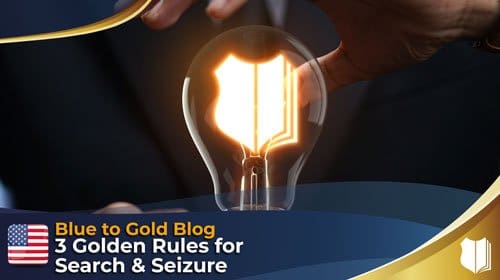

What is the Motor Vehicle Exception?
The automobile, or motor vehicle exception allows officers to search cars for evidence, contraband, and fruits or instrumentalities of crimes without a search warrant. When
or use our live chat
Customer Service


What is the difference between reasonable suspicion and probable cause? It’s a great question, because even the courts struggle with defining the difference. There is no one definition that’s in the legal dictionary, so let’s look at them separately.
First of all, we have to find a hunch. Every officer can have a hunch. Officers will look at somebody, look at a situation, and feel that something is up here. That is a hunch. They’re unpredictable. They’re like something on the back of your neck, the hairs going up. But you can’t do anything with those.
You can watch, but the only thing you can do is to have a consensual encounter. Such as, “Hey, guy; can I talk to you for a second?” and maybe try to follow the breadcrumbs and see if you get something more.
You can’t detain somebody over a hunch. But you can with reasonable suspicion.
The difference is, it’s particularized. That means that the cop can put his finger on something particular about this guy, this environment, and say that something is up.
You have to also remember the goal of reasonable suspicion. The goal of reasonable suspicion is crime prevention, not crime apprehension. You may apprehend somebody, and you may determine that they are involved in criminal activity.
But your goal is to prevent major crimes from happening in the first place. And the reason why that’s important is because reasonable suspicion, by very definition, is that you’re looking at something and no crime has necessarily occurred.
Think about Terry versus Ohio. Officer Martin McFadden, 38 years on the job with Cleveland PD, knows a thing or two about crime. And he sees Terry and his friends going back and forth in front of that sucker’s department store. Well, going back and forth in front of a store several times is not a crime. That’s called aggressive window shopping in my family.
But Martin is no fool. There are other things going on. Terry’s talking to people on the corner, they then go to the front of the window, and they look, and then they meet up again, and one takes off to another corner, maybe going to the other side of the store. So this is not aggressive window shopping. Martin thinks that this is a setup for an armed robbery. And he was right.
But Martin McFadden stopped Terry and prevented an armed robbery from occurring that day. Terry got convicted of concealed weapon charges. He didn’t get convicted of attempted armed robbery, because there wasn’t enough there for the attempt part.
That was Terry versus Ohio.
To wrap up reasonable suspicion, do you have something particular? Do some facts and circumstances lead you to believe that this person, right now, is engaged in something that is some kind of criminal activity? Yet what you’re seeing is not necessarily a crime, right? (If it was we would call that probable cause.)
Let me give you another example. An officer is patrolling at night, around two o’clock in the morning. And this area of town has a lot of graffiti issues. Maybe it’s recent, maybe it’s long term, whatever. He sees this guy walking down the street, kind of looking around. The guy sees the car, a marked unit, and takes an immediate next right. Okay, people have the right to avoid a police officer. That’s a hunch; that’s raising suspicion.
So the cop then follows the guy, who goes into the alleyway. He also notices that the guy has something in his pocket the size of a paint can. A rattle can. And you probably have enough. If you’re confident in your articulation and describing the whole environment, you can detain that guy temporarily to find out if he is getting ready to attack something.
The evasiveness, the underlying criminal activity in that area, and this object that appears to be a rattle can; that’s kind of odd. That’s a big object in somebody’s pocket. So that’s what you want. If you stop them at the point of evasiveness, you lose, but if you stop them at the point of when you put all these pieces together, you probably have enough for reasonable suspicion.
Now we move into probable cause. Probable cause to arrest is; facts and circumstances that lead a reasonable officer to believe that a crime has been committed and that the person you arrested has likely committed it. It’s not a super high standard.
When I ask cops, “How much certainty do you need to have for probable cause?”; I sometimes get “70 to 80%.” That’s not accurate. That standard is way too high. In fact, that’s pushing it into the realm of beyond a reasonable doubt. So it’s a much lower standard. It’s around that 50% mark, probably lower than 50%, even though you’re probably taught that it’s higher. But when push comes to shove, per the case law, it’s probably lower. But the point is, that it’s not very high. You just have to describe why you think this person has committed a crime.
I hope that helps. Until next time, stay safe.


The automobile, or motor vehicle exception allows officers to search cars for evidence, contraband, and fruits or instrumentalities of crimes without a search warrant. When


These three golden rules come from reading thousands of court cases over the last 20 years and seeing a theme regarding what the courts are


This question is: Can you look inside a woman’s purse, or a man’s backpack during a pat down? The answer is, “Maybe.” Here’s how this


Here is the question: Can an officer reach slightly into a person’s home to pull them out and arrest them? If an officer has probable
© Blue to Gold, LLC. All rights reserved